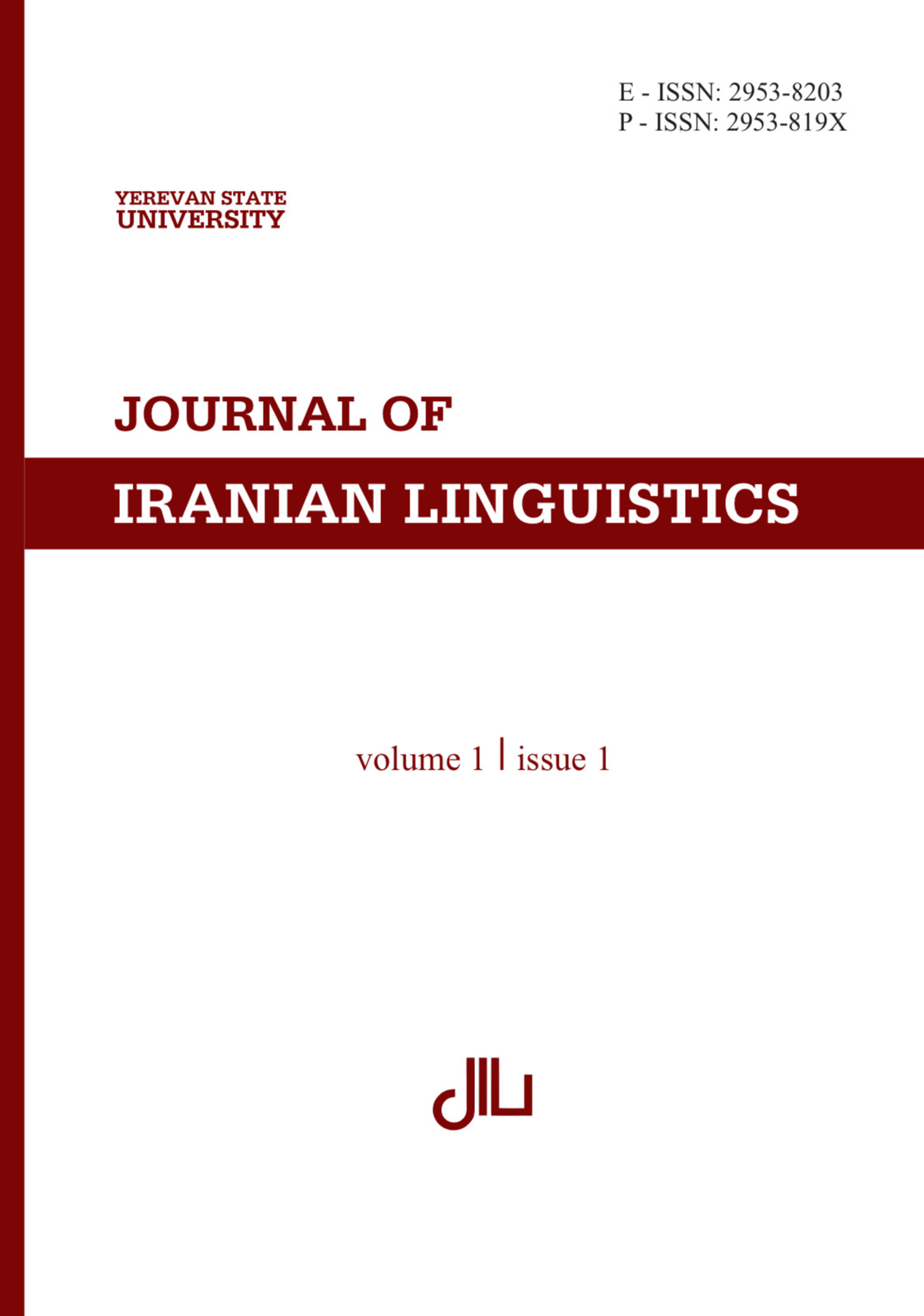Low vowel dissimilation in Mazandarani
DOI:
https://doi.org/10.46991/jil/2024.01.08Keywords:
loanword adaptation, low vowel dissimilation, Mazandarani, verbal morphology, vowel raisingAbstract
Similar patterns of vowel change in loanword adaptation have been documented for several Iranian languages and language varieties including Mazandarani. However, no convincing accounts of the nature of these processes in Mazandarani have been presented in the literature. We argue that for this language, these vowel alternations are best explained as low vowel dissimilation, a process affecting adjacent syllables with low vowels whereby one of the vowels is raised. Low vowel dissimilation is typologically rare, with the overwhelming majority of the cases identified belonging to the Oceanic family. To show that the vowel changes in question are indeed cases of low vowel dissimilation, we invoke evidence from the language’s verbal morphophonology where vowel changes show a more regular behavior and then expand the analysis to loanword adaptation. The dialects discussed in the articles are those of Amol, Reineh, and Babol. The two vowels that trigger the process in Mazandarani are the low vowels /æ/ and /ɑ/, but only the former can undergo change. We show that unlike almost all other known cases of this phenomenon, it is the second vowel that undergoes raising in the Mazandarani case in many situations, with this seemingly being the preferred way in the dialect of Babol. We end the paper with a discussion of why the two low vowels behave differently, suggesting that /ɑ/’s resistance to change is due to the fact that it is a long vowel phonologically, even if not phonetically.
References
Aronow, Robin and Brian McHugh and Tessa Molnar. 2017. “A pilot acoustic study of Modern Persian vowels in colloquial speech.” In Proceedings of the Linguistic Society of America 2: 1–7.
Bennet, Wm. G. “The Phonology of Consonants.” Cambridge University Press.
Blevins, Juliette. 2009. “Low Vowel Dissimilation outside of Oceanic: The case of Alamblak.” Oceanic Linguistics 48 (2): 477–83.
Blust, Robert. 1996a. “Low Vowel Dissimilation in Ere.” Oceanic Linguistics 35 (1): 96–112.
Blust, Robert. 1996b. “Low Vowel Dissimilation in Oceanic Languages: An Addendum.” Oceanic Linguistics 35 (2): 305–9.
Borjian, Habib. 2019. “Mazandarani: A typological survey.” Essays on Typology of Iranian Languages 328: 79.
Borjian, Maryam, and Habib Borjian. 2007. “Ethno-linguistic materials from rural Mazandaran.” Iran and the Caucasus 11 (2): 227–48.
Bruce, Les. 1984. The Alamblak Language of Papua New Guinea (East Sepik). Dept. of Linguistics, Research School of Pacific Studies, The Australian ….
Ebert, Karen H. 1979. “Sprache und Tradition der Kera (Tschad). Teil III: Grammatik.” Berlin: Dietrich Reimer.
Fatemi, Sasan. 2014. “Rythmique enfantine en Iran.” Revue des Traditions Musicales des Mondes Arabe et Méditerranéen 8: 85–108.
Hayes, Bruce. 1989. “Compensatory lengthening in moraic phonology.” Linguistic Inquiry 20 (2): 253–306.
Kord Zafaranlu Kambuzia, Aliyeh, and Tahereh Ezatabadi Pour. 2018. “Barresi-e farâyand-e erteqâ-ye vâke va vâjhguni-e in qâ’ede dar gunehâ-ye zabân-e fârsi: ruykard-e zâyeshi [Vowel raising and its rule conversion in varieties of Persian language: A generative phonology approach.]” Motâle’ât-e zabânhâ va guyeshhâ-ye gharb-e irân. 5 (1): 19–36.
Lazard, Gilbert. 1957. “Grammaire du Persan Contemporain.” Paris: Lib C Klincksieck.
Lynch, John. 2003. “Low Vowel Dissimilation in Vanuatu languages.” Oceanic Linguistics 42 (2): 359–406.
Mahdavi Mazdeh, Mohsen. 2020. “The quantitative nature of meters in Persian folk songs and pop song lyrics,” in Larson, R., Moradi, S., and Samiian, V. (eds) Advances in Iranian Linguistics. John Benjamins.
Modarresi Ghavami, Golnaz. 2014. “Negâh-i diagar be vijhegihâ-ye sowtshenâkhti-e vâkehâ-ye kutâh va boland dar zabân-e fârsi [Another look at the acoustic features of short and long vowels in Persian.]”
Modarresi Ghavami, Golnaz. 2020. “Naqsh-e sâkht-e hejâ dar farâyand-e erteqâ-ye vâke dar zabânhâ va guyeshhâ-ye irâni [The role of syllable structure in vowel raising in Iranian languages and dialects]” Zabân va zabânshenâsi 16 (2), 31–48.
Pitkin, Harvey. 1984. “Wintu grammar.” Berkeley: University of California Press.
Rastorgueva, V. S., Kerimova, A. A., Mamedzade, A. K., Pireiko, L. A., Edel’man, D. I., & Lockwood, R. M. (2012). The Gilaki language. Acta Universitatis Upsaliensis.
Rahmani, Hamed. 2019. “An evidence-based new analysis of Persian word prosody.” Amsterdam: LOT.
Sadeghi, Vahid. 2015. “Barresi-e âvayi-e kâhesh-e vâke’i dar zabân-e fârsi [Phonetic measurement of vowel reduction in Persian].” Jostârhâ-ye zabâni 6 (3), 165–187.
Shahidi, Minoo. 2008. “Sociolinguistic Study of Language Shift in Mazandarani.” Uppsala Universitet.
Vahidian Kamyar, Taghi. “Barresi-e vazn-e she’r-e âmiâne [A study of meter in folk poetry].” Tehran: Âgâh.
Toosarvandani, Maziar Doustdar. 2004. “Vowel Length in Modern Farsi.” Journal of the Royal Asiatic Society 14 (3): 241–51.
Downloads
Published
How to Cite
Issue
Section
License
Copyright (c) 2024 Mohsen Mahdavi Mazdeh, Sarah Nehzati

This work is licensed under a Creative Commons Attribution-NonCommercial 4.0 International License.


